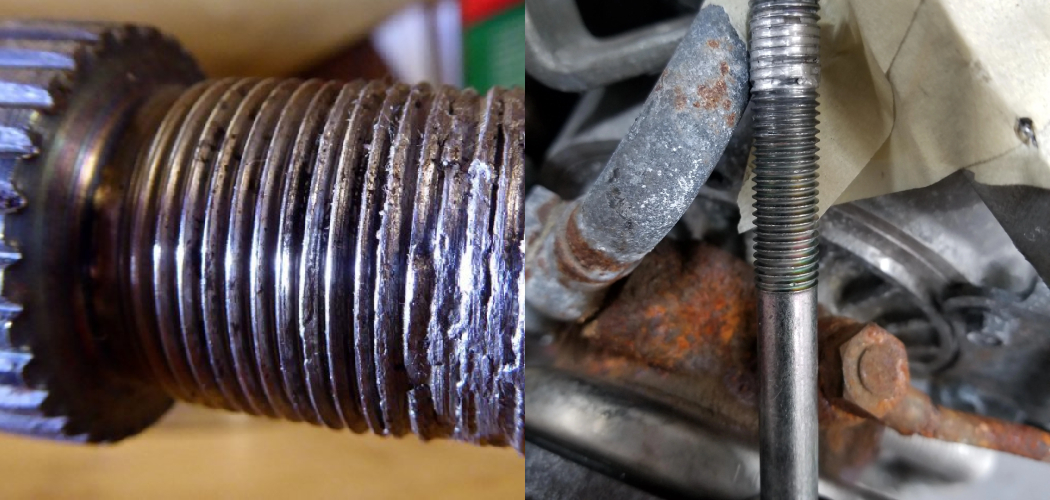Working on a project and suddenly realize you’ve accidentally cross-threaded a bolt? Don’t panic! Cross-threading bolts is a common issue, but it can be frustrating and even dangerous if not handled correctly. We’ve put together this comprehensive guide to help you understand what cross-threading is, its potential risks, and the various ways to fix it safely and effectively.

Image: repairious.com
In this article, we’ll delve into the mechanics of cross-threading, discuss different methods to resolve the issue, and provide tips and advice to avoid cross-threading in the future. Whether you’re a seasoned pro or a DIY enthusiast, this guide will empower you with the knowledge and skills to handle cross-threaded bolts with confidence.
The Perils of Cross-Threading: A Preventable Catastrophe
Cross-threading occurs when a bolt is forced into a nut or hole at an angle instead of straight alignment. This can damage the threads of the bolt, nut, or both, making it difficult or impossible to fasten or remove the bolt securely.
The dangers of cross-threading are not just cosmetic; they can have serious structural consequences. Cross-threaded bolts may not provide adequate clamping force, leading to a weak joint that could fail under stress. In extreme cases, cross-threading can cause the bolt or nut to break, potentially causing damage to the surrounding machinery or even personal injury.
Fixing Cross-Threaded Bolts: A Step-by-Step Guide
If the damage is minor, you may be able to salvage the bolt using these methods:
- Reverse and Restart: Gently try to reverse the bolt or nut. If it loosens, then re-align it and start threading again.
- Use a Thread Repair Tool: These tools use a die or tap to recut damaged threads on both the bolt and nut, creating a fresh, aligned connection.
- Use a Back-Out Bit: This specialized tool can help extract cross-threaded bolts without causing further damage.
For more severe cross-threading, consider these options:
- Replace the Bolt and Nut: Cut or grind off the cross-threaded bolt and replace it with a new one. A new nut may also be necessary.
- Drill Out the Hole: Enlarge the hole in the material to a larger size, allowing you to tap new threads and use a larger bolt.
- Weld a Nut to the Bolt: If the bolt is an odd size or not easily replaceable, weld a nut onto the bolt and use that to fasten it into place.
Prevention is Key: Tips to Avoid Cross-Threading
- Start Straight: Align the bolt perpendicular to the hole before starting to thread.
- Turn Slowly: Thread the bolt or nut gradually, feeling for any resistance or binding.
- Use a Wrench: Avoid using fingers or power tools to thread bolts, as they can apply uneven force and cause cross-threading.
- Lubricate Threads: Applying a lubricant to the threads can reduce friction and prevent binding.
- Use the Right Tools: Ensure you have the correct size wrench or socket for the bolt.

Image: www.youtube.com
Expert Advice and Final Thoughts
When handling cross-threaded bolts, safety should be your top priority. Always wear appropriate protective gear and avoid using excessive force. If you encounter any difficulties, don’t hesitate to seek the help of a qualified mechanic or professional.
Taking the time to properly fix cross-threaded bolts will save you time and money in the long run. By following the guidelines outlined in this article, you can avoid the risks associated with cross-threading and ensure that your projects are completed safely and securely.
Frequently Asked Questions
Q: What are the signs of a cross-threaded bolt?
A: Signs include difficulty threading, excessive resistance, metal shavings, or the bolt going in at an angle.
Q: Can I reuse a cross-threaded bolt?
A: In some cases, minor cross-threading can be corrected with a thread repair tool. However, severely cross-threaded bolts should be replaced.
Q: How can I prevent cross-threading in the future?
A: Use proper tools, pay attention to alignment, start slowly, and lubricate threads to avoid binding.
How To Fix Cross Threaded Bolt
Call to Action
If you’ve ever struggled with cross-threaded bolts, this comprehensive guide provides you with the knowledge and tools to handle them with confidence. Remember, prevention is always better than cure. By following these tips, you can avoid cross-threading and ensure that your projects are completed to a high standard.
Have you ever had to deal with cross-threaded bolts? Share your experiences and tips in the comments section below.